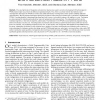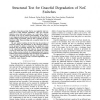17 search results - page 2 / 4 » Yield Improvement, Fault-Tolerance to the Rescue |
FPGA
2006
ACM
13 years 11 months ago
2006
ACM
The high unit cost of FPGA devices often deters their use beyond the prototyping stage. Efforts have been made to reduce the part-cost of FPGA devices, resulting in the developmen...
ICCAD
2005
IEEE
14 years 4 months ago
2005
IEEE
— Yield improvement through exploiting fault-free sections of defective chips is a well-known technique [1][2]. The idea is to partition the circuitry of a chip in a way that fau...
TC
1998
13 years 7 months ago
1998
—The very high levels of integration and submicron device sizes used in current and emerging VLSI technologies for FPGAs lead to higher occurrences of defects and operational fau...
ETS
2011
IEEE
12 years 7 months ago
2011
IEEE
Abstract—Networks-on-Chip (NoCs) are implicitly fault tolerant due to their inherent redundancy. They can overcome defective cores, links and switches. As a side effect, yield is...
ISCA
2005
IEEE
14 years 28 days ago
2005
IEEE
Scaling feature size improves processor performance but increases each device’s susceptibility to defects (i.e., hard errors). As a result, fabrication technology must improve s...


